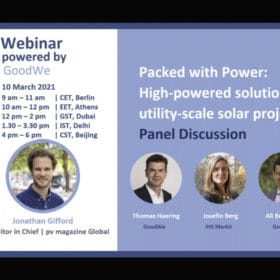Each record-setting year
While much was supposedly “unprecedented” about 2020, some historians may beg to differ. As 2021 dawns, one thing has definitely never been seen before, and that is that solar, under the right circumstances, is very much the cheapest source of electricity on earth.
Solar surges, storage up next
The forecasting of global PV installations is best done at a safe distance. The ability of PV to be installed quickly, and the spikes in installations before a certain subsidy program winds up, or when project completion is required under a tender, often results in a surge of deployment – sometimes far beyond the expectations of even the most courageous analyst.
Green shoots of recovery
There is a sense of cautious optimism with signs of an end to the tumult and disruption that have been a feature of the last 12 months, and for those of us who live in the northern hemisphere, the first green shoots of spring.
When quality meets quantity
As 2021 progresses, the signs of it being (yet another) banner year for PV deployment become clearer. An increasing number of market observers are tipping that solar deployment globally will pass the 150 GW mark for the first time. And energy storage is also ramping fast.
Growing pains
The switch to large-format PV cells and modules has pushed the boundaries of what many in the solar industry thought possible. And it caught the rest by surprise. But the logic behind the change makes sense – getting more throughput in terms of watt-peak through cell and module lines, and allowing for longer module rows in PV projects, delivering BOS savings and lower LCOE.
Europe’s back in business
Spain, the Czech Republic, Italy, and then Germany: the PV markets of Europe were instrumental in delivering the demand required to build a solar industry of any scale and to set the industrial wheels in motion toward dramatic cost reductions. And today, as European markets set a course for substantial and sustained growth, solar modules cost just 5% of what they did some 12 years ago.
Invention, the mother of necessity
From want to need; it’s a marketer’s dream, but it’s precisely the transition that solar has undergone over the last 10-15 years. Previously, PV was an expensive product, cost effective only when the provision of electricity from fossil fuels was prohibitively high or in the domain of environmentalist diehards, committed to low carbon technology no matter the cost.
More in store
The battery energy storage system (BESS) market is expected to double year on year in 2021, exceeding a volume of 10 GW, according to IHS Markit (pp. 12-13). For many this would appear an outstanding performance and a sign that battery deployment is at an inflection point – with nothing but good times in store.
At a crossroads
The rapid growth currently underway in the U.S. solar market is impressive to behold. More than 40% year-on-year growth is nothing short of stellar. Looking at the market segments, the residential rooftop business appears to be becoming more streamlined and shedding some of the overheads that had maintained relatively high prices. Innovations are being adopted in the commercial and industrial rooftop solar sector (pp. 78-80). And at the utility scale, a mix of state-level policies like Renewable Portfolio Standards, an ongoing appetite for PPAs, and the continued support of the Investment Tax Credit (pp. 20-23) look to have provided fertile turf for solar developers.
Solar steps on the gas
Acceleration is the name of the game as the solar industry moves into the year’s final quarter. Global action on climate change is picking up as world leaders prepare to meet in Glasgow early next month for the COP26 negotiations. Reflecting this momentum, BloombergNEF now expects 191 GW of PV to be installed in 2021 – now the mid-scenario of the research company’s solar forecast.










